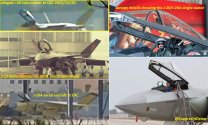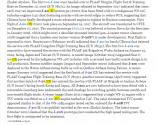Having a second seat is almost always better in the BVR age than a single pilot. The issue is that the US struggles to even find enough pilots to fill its current fleet. The US needs to rely on AI whereas China has the man power to provide second seats. There's pros and cons for each option.
I don't think such generalizations are true.
A single pilot can certainly conduct BVR engagements with modern sensors and avionics and cockpits, they've been able to do so for many years now.
The addition of a second human purely for the purpose of BVR engagements is not really necessary.
Furthermore, the PLA are also making significant efforts to pursue AI as well, and manpower and AI are ultimately complementary to each other, rather than being viewed as one replacing the other.
The role of a second seat IMO is best viewed in the below context:
1. The capacity of an aircraft crew to perform a variety of tasks simultaneously, will increase with greater crew size, regardless of degree of automation or AI. That is to say, an aircraft with XYZ level of automation and AI, where the crew size is only one pilot, will still be significantly more limited compared to a different aircraft with the same XYZ level of automation and AI but with a crew size of two. That is because even with all of the automation and AI at your disposal, you still need a human being to make sense of the outputs and make tactical decisions in terms of who should engage what targets, and what kind of information and instructions should be shared with whom. The number of human beings is the rate limiting factor, and in an aircraft with a single pilot, their primary role will still be to fly the aircraft and monitor the battlespace in a manner to allow them to be wary of enemy aircraft even if they were tasked to operate in a support role -- they cannot 100% be focused on the role of battle management in the way a second pilot can.
2. Modern aerial warfare is becoming increasingly networked. In the recent past to now, a single pilot can conduct a BVR engagement without much issue -- in fact a single pilot can conduct multiple simultaneous BVR engagements without issue with contemporary technology. However, as more stealth aircraft enter service, as more capable EW platforms enter service, as more UAVs/UCAVs enter service, and as air fleets become increasingly networked, the ability to know what all of your assets are doing and what they're seeing and what they're firing at, and to support all of those actions, while simultaneously being able to out network your enemy, that becomes much more important. The short form of it can be called battle management/networking capability.
3. Traditional battle management/networking platforms are becoming more and more vulnerable. Traditional AEW&C and airborne command posts are slow, non-stealthy aircraft that operate hundreds of km behind the "frontline" of where air combat is happening, for their own safety. But with stealth aircraft, as well as due to longer ranged missiles, these AEW&C and airborne command posts are becoming more and more vulnerable. Their capability will still be needed, but they'll likely operate in a more conservative and more well guarded fashion. They will also be supplemented by a variety of more distributed and survivable systems, likely to involve UAVs of various kinds -- but a twin seater 5th generation aircraft can also play a significant role. The sensing and networking and automation capability of a 5th generation aircraft should already be very, very advanced, and allows it to perform their primary combat roles very effectively. But adding in another human being in the cockpit, will enable the extra second human being to use that same sensing, networking and automation capability to focus on overseeing, communicating, and managing the battlespace, while simultaneously being able to have the same kind of survivability as a standard 5th generation fighter (and thus able to operate far closer to the "frontline" and also therefore able to maintain more secure datalinks with friendly aircraft).
Take all of that together, and I think that a twin seater J-20S makes a lot of sense, as a reflection of the emerging trends of modern aerial warfare, as well as the fact that regardless of how much automation and AI can advance the ability of a single human to perform multiple tasks, that two humans are significantly better than one, especially for a combat aircraft where one human still has to fly the plane and perform (at minimum) self defense.
Basically, I see a J-20S as a fully combat capable J-20 but with significant elements of the AEW&C/airborne command post mission allocated to it, to result in a very survivable and very lethal, battle management/networking node that helps to supplement the overall transition of the AEW&C/battle management/airborne command mission to a more distributed, more survivable and more dynamic framework.



